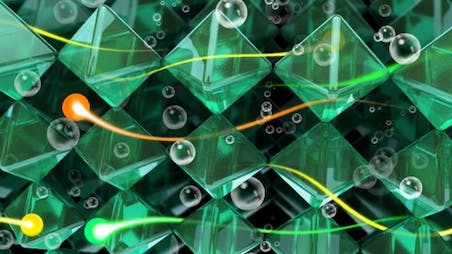While energy sources such as wind and solar are great at producing emissions-free electricity, they depend on the sun and the wind, so supply doesn’t always meet the demand. Likewise, nuclear power plants operate more efficiently at maximum capacity so that electricity generation can’t be easily ramped up or down to match demand.
For decades, energy researchers have tried to solve one big challenge: How do you store excess electricity so it can be released back onto the grid when it’s needed?
Recently, researchers at Idaho National Laboratory helped answer that challenge by developing a new electrode material for an electrochemical cell that can efficiently convert excess electricity and water into hydrogen. When demand for electricity increases, the electrochemical cell is reversible, converting hydrogen back into electricity for the grid. The hydrogen could also be used as fuel for heat, vehicles or other applications.
The results appeared online this week in the journal Nature Communications.

Researchers have long recognized the potential of hydrogen as an energy storage medium, said Dong Ding, a senior staff engineer/scientist and chemical processing group lead at INL.
“The energy storage grand challenge, with its diverse research and development needs, gave rise to more opportunities for hydrogen,” said Ding. “We are targeting hydrogen as the energy intermediate to efficiently store energy.”
Ding and his colleagues improved one type of electrochemical cell called a protonic ceramic electrochemical cell (PCEC), which uses electricity to split steam into hydrogen and oxygen.
However, in the past, these devices had limitations, especially the fact that they operate at temperatures as high as 800 degrees C. The high temperatures require expensive materials and result in faster degradation, making the electrochemical cells cost prohibitive.
In the paper, Ding and colleagues describe a new material for the oxygen electrode—the conductor that facilitates the water splitting and oxygen reduction reactions simultaneously. Unlike most electrochemical cells, this new material—an oxide of a compound called a perovskite—allows the cell to convert hydrogen and oxygen into electricity without additional hydrogen.
Previously, Ding and his colleagues developed a 3D meshlike architecture for the electrode that made more surface area available to split the water into hydrogen and oxygen. Together, the two technologies—the 3D mesh electrode and the new electrode material—allowed for self-sustainable, reversible operation at 400 to 600 degrees C.
“We demonstrated the feasibility of reversible operation of the PCEC at such low temperatures to convert generated hydrogen in hydrolysis mode to electricity, without any external hydrogen supply, in a self-sustaining operation,” Ding said. “It’s a big step for high temperature electrolysis.”
While past oxygen electrodes conducted only electrons and oxygen ions, the new perovskite is “triple conducting,” Ding said, meaning it conducts electrons, oxygen ions and protons. In practical terms, the triple-conducting electrode means the reaction happens faster and more efficiently, so the operating temperature can be reduced while maintaining good performance.
For Ding and his colleagues, the trick was figuring out how to add the element to the perovskite electrode material that would give it the triple-conducting properties—a process called doping. “We successfully demonstrated an effective doping strategy to develop a good triple-conducting oxide, which enables good cell performance at reduced temperatures,” said Hanping Ding, a materials scientist and engineer for Idaho National Laboratory’s Chemical Processing Group.
In the future, Dong Ding and his colleagues hope to continue improving the electrochemical cell by combining materials innovation with cutting-edge manufacturing processes so the technology can be used at an industrial scale.
Learn more about the group’s previous progress in this area: https://inl.gov/article/new-technology-improves-hydrogen-manufacturing/
INL is a U.S. Department of Energy (DOE) national laboratory that performs work in each of DOE’s strategic goal areas: energy, national security, science and environment. INL is the nation’s center for nuclear energy research and development. Day-to-day management and operation of the laboratory is the responsibility of Battelle Energy Alliance.
See more INL news at www.inl.gov. Follow us on social media: Twitter, Facebook, Instagram and LinkedIn.
—INL-20-016—
By INL Media Relations





